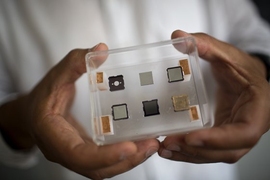In the darkness of 2 a.m. on Aug. 26, the sky over Cape Canaveral, Florida, lit up with the bright plume of a Minotaur rocket lifting off from its launch pad. Aboard the rocket, a satellite developed by MIT's Lincoln Laboratory for the U.S. Air Force's Operationally Responsive Space (ORS) Office awaited its deployment into low Earth orbit.
The ORS-5 SensorSat spacecraft is on a 3-year mission to continually scan the geosynchronous belt, which at about 36,000 kilometers above Earth is home to a great number of satellites indispensable to the national economy and security. Data collected by SensorSat will help the United States keep a protective eye on the movements of satellites and space debris in the belt.
"There was nothing like seeing the massive Minotaur IV blast our creation into orbit, and then getting those familiar telemetry messages to indicate that it's really up there and operating just as it did in thermal-vacuum testing," says Andrew Stimac, the SensorSat program manager and assistant leader of the Lincoln Laboratory's Integrated Systems and Concepts Group.
In the months that SensorSat has been in orbit, it has undergone a complete checkout process, opened the cover of its optical system, and collected the first imagery of objects in the geosynchronous belt. The quality of the initial images has demonstrated that SensorSat utilizes a highly capable optical system that is able to conduct its required mission.
The 226-pound SensorSat is small in comparison to current U.S. satellites that monitor activity in the geosynchronous belt. SensorSat's size and its optical system design, which uses a smaller aperture, make it a lower-cost, faster-built option for space surveillance missions than the large systems designed for missions of 10 years or more.
"SensorSat is essentially a simple design, but it is a highly sensitive instrument that is one-tenth the size and one-tenth the cost of today's large satellites," says Grant Stokes, head of the Lincoln Laboratory's Space Systems and Technology Division, which collaborated with the Engineering Division to develop and build the satellite.
Traditional large surveillance satellites are designed to collect data on objects known to be in the geosynchronous belt. The optical systems on those satellites are mounted on gimbals so that they can turn their focus toward the targeted objects. SensorSat works on a different concept: Its fixed optical system surveys each portion of the belt that is within its current field of view as the satellite orbits Earth.
SensorSat makes approximately 14 passes around Earth each day, providing up-to-date views of activity in the geosynchronous belt. Stokes compared SensorSat's surveillance process to that of airport radars that continuously rotate to visualize a local airspace. Because SensorSat is not aimed at specific known objects, a secondary benefit to its concept of operations is that it may see new objects that pose threats to satellites within the belt.
The adoption of SensorSat-like systems that can be cost-effectively built on short timelines could also make it practical for the United States to more frequently deploy new satellites to keep pace with evolving technology.
SensorSat development and testing were accomplished in just three years, a period about one-third of that needed to develop and field large surveillance satellites. The SensorSat engineering effort involved the design, fabrication, and testing of the satellite structure and cover mechanism, lens optomechanics, telescope baffle, charge-coupled device packaging, electrical cabling, and thermal control.
The assembly, integration, and testing were conducted in Lincoln Laboratory's cleanroom facilities and its Engineering Test Laboratory. According to Mark Bury, assistant leader of the Laboratory's Structural and Thermal-Fluids Engineering Group, the shock, vibration, attitude control system, and thermal-vacuum testing performed were critical in validating SensorSat against the expected launch and space conditions it would need to endure.
"Perhaps the most important events occurred during thermal-vacuum testing," Bury says. "The satellite is exposed to conditions similar to those on orbit, and we used that test to validate our thermal design. Even more important, the thermal-vacuum test enabled us to get significant runtime on the avionics and components within the spacecraft, emulating the communication cadence and data streams that we would eventually see on orbit."
On July 7, less than two months before launch, SensorSat was shipped to Florida for installation on Orbital ATK's Minotaur IV inside a large cleanroom facility at Astrotech Space Operations, locatedjust outside the Kennedy Space Center. A team from Lincoln Laboratory performed final assembly steps and prepared the satellite with the software uploads needed initially on orbit.
Joint operations were then conducted with Orbital ATK to complete the mechanical and electrical integration prior to encapsulation with the rocket fairing. The integrated assembly was then transported from Astrotech to the Cape Canaveral Air Force Station launch pad 46 in mid-August.
SensorSat, which resides directly above the equator, orbits at an inclination of zero degrees, an orientation that Stokes says required very precise deployment of the satellite. The Minotaur IV, modified from a 25-year-old Air Force rocket design and now operated by Orbital ATK, was up to the challenge, using two new rocket motors to provide the extra lift needed to reach the equatorial orbit.
SensorSat is now orbiting Earth and collecting data to fulfill its space surveillance mission.











